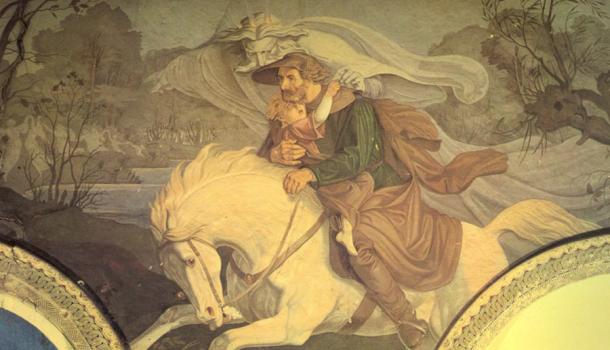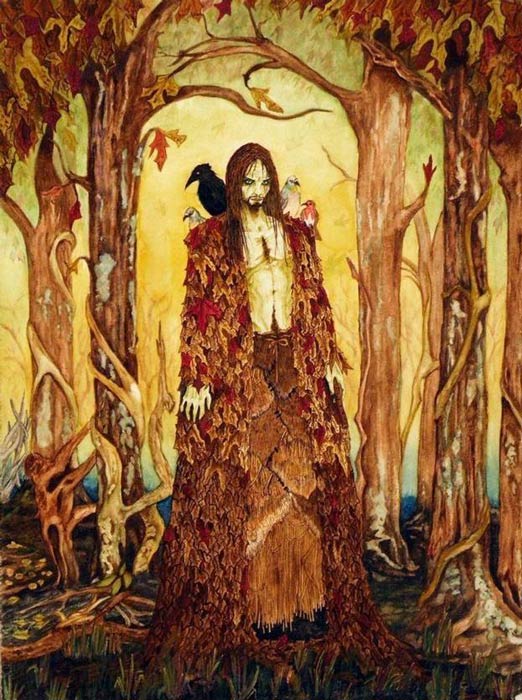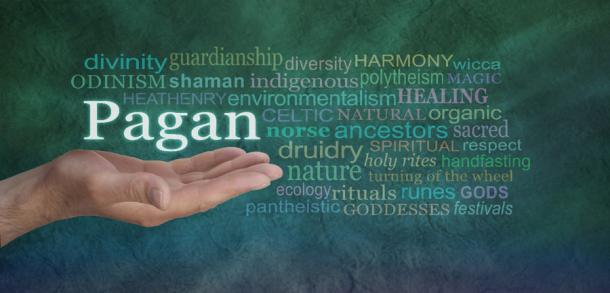
The Erlking: The Powerful Germanic Mythical Snatcher of Children
European traditional folklore is full of diverse and mythical creatures both good and bad. Often enough, they become popular again during the time of Christmas or Halloween, when the stories of their mischievous deeds and daring adventures are retold. Some of them, like the Krampus, are used to scare particularly naughty youngsters, while others like Santa Claus are used to motivate and inspire. One of the lesser known creatures from European folklore is the infamous Erlking , a powerful Elf King that snatches children away in the forest depths and on remote pathways. Though somewhat obscure today, the Erlking nevertheless has very deep and important origins that should not be forgotten. So, who is this scary elf king, and what are the secrets of the Erlking’s ancient origins?

A lithograph by Albert Sterner of the Erlking. (liveauctioneers)
Digging Deep to Find the Ancient Origins of the Erlking
The name Erlking is of Germanic origin and is a modernized form of a far older name. In modern translation it literally means “alder king.” This being is described as a mischievous, sinister elf, who both dwells and lingers in the woods. Elsewhere, he is described as a bearded goblin, or a troll of small stature. Either way, his nature is malignant: he preys on children, especially those that wander off into the woods or stay there after dark. According to myth, the Erlking has the power to kill children with a single touch.
The Erlking became very popular during the period of German Romanticism, which in the late 18th and early 19th centuries influenced philosophy, aesthetics, literature and criticism in Europe. This mythological figure was dubbed the “king of the fairies” and was likely adopted in Germany from the older Danish legend of the “Ellekonge,” the Elf King.
The Erlking was first mentioned in the ballad titled the “Erlkönigs Tochter” (the Elf-king’s Daughter), which was written by Johann Gottfried Herder in 1778. The ballad was an adaptation of the similar Danish work called “Hr. Oluf han rider” ("Sir Oluf he rides"), published in the 1739 edition of “Danske Kæmpeviser.”
- Wayland the Smith: The Lost Germanic Legend of the Flying Blacksmith
- Gold Pendant Found in Denmark Depicts Norse God Odin, and May Have Been a Sacrifice to Avert the Disastrous Weather of 536 AD
But the real popularity of the Erlking came in 1782, when the genius German poet, Johann Wolfgang von Goethe, published a long poem titled the “Erlkönig.” A story about a child snatched away and killed by a supernatural villain, the Erlking. The poem has often been referred to as “Goethe’s most famous ballad.” The ballad was a great success at the time it was published. And in the following years, its popularity kept rising when Goethe’s work was set to music by some of the leading German composers of the time. The legendary Franz Schubert composed his classical piece, the "Erlkönig," Op. 1, D 328, in 1815. It was set to follow the poem itself. The composer Carl Loewe also set the poem to music, in his 1817-1818 classical piece.

In this painting the Alder King, another name and version of the Erlking myth, is trying to snatch a child. (Public domain)
The Elf King and the Alder King
But all of that can be considered as the “modern face” of the Erlking, which largely overshadows his more ancient past. Examining traditional European folklore, scholars began digging deeper to discover the Erlking’s origins. Jacob Grimm (1785-1863), a prominent German folklorist and linguist, connected the name to the Danish word ellekonge meaning “king of the elves.” The name was popularly related to the elverkongens datter (the Elf-king’s daughter), a mischievous creature of the woods that charms and ensnares humans in order to satisfy her lust and jealousy. But here’s where the errors occur.
The Danish Elf King and the German Erlking don’t have the same names. Where ellekonge is an “Elf” king, the Erlking is an “Alder” king. So, what gives?
The Danish word was actually mistranslated! Johann Gottfried Herder, when writing his ballad "Erlkönigs Tochter" in 1778, incorrectly translated the creature’s name from Danish resulting in the name Alder King. The proper German name would thus be Elbkönig or Elfenkönig, matching the Danish origins. But all of this is quite superficial. Because the origins of both stories are buried far deeper in the European past. They lie in a time when ghouls and ghosts were gods and giants, and the world was set to the pace of age-old traditions and observations of nature. The Erlking too was once a God.
The secret is hidden in language and in shared origins. When observing the shared myths of the ancient Germanic peoples, and when digging deep into the pan-European traditions, one can quickly see that the Erlking is not at all that obscure. In fact, he is a remnant of something greater and more powerful.

It is said that the French Harlequin was an early interpretation of the Erlking. This harlequin image is on a park bench in Pulsnitz Germany, where most of the earliest references to the Erlking are found. (Lupus in Saxonia / CC BY-SA 4.0)
Herla Cyning Rides Across the Skies
The first clue lies in an old Anglo-Saxon mythical figure the Herla Cyning, or Herla King. Right off the bat, you can see the connection in the names of Herlaking and Erlking. That is because they are likely the very same myth. For the Anglo-Saxons, and later the medieval English, King Herla was the fabled leader of the Wild Hunt, the classic Germanic myth shared amongst all Germanic tribes. But the leader of the Wild Hunt was none-other than Odin, the chief god of the Germanic pantheon. For the Anglo-Saxons, he was Woden, and the memory of this god survived in King Herla. And by no accident. It is quite possible that Herla is just another name for Odin. The god had hundreds of varied and well-attested names and was often known by nicknames.
In the writings of the twelfth century writer Walter Map (circa 1130-1210), Herla Cyning is said to be the legendary King of the Britons, the man that went to the otherworld and emerged some three hundred years later, when his lands were occupied by the Anglo-Saxons. He then became the leader of the Wild Hunt. It is clear that the Wild Hunt myth begins only with the establishment of Anglo-Saxon rule and the influences of pagan Germanic myth. Either way, the Wild Hunt was known in England by various names, the chief of these being Herlaþing (Herla’s Assembly), or Woden’s Hunt.
- Pagan Gods and the naming of the days
- The Temple at the Gates of Dawn: Ancient Sites are Forever Sacred - It’s only the Name of the Gods That Change
And the similarities across Europe just keep mounting. The next clue lies in medieval France, where a similar myth exists. There, the evil mythical creature was known as the Herlequin, and was first attested in the 11th century AD by the chronicler Orderic Vitalis. The man described the “herlequin” as a great giant, his face painted red and black, and wielding a great club. He was the leader of a troop of wild creatures and demons called the “herlethingi.” This wild assembly purportedly chased a monk across the countryside.
Of course, we can at once spot the similarities: “Herlequin” and “Herlaking,” and “herlethingi” and “ Herlaþing (Herlathing).” Furthermore, the figure of the Herlequin was established in the French version of the Germanic Wild Hunt, which was called the “ Mesnée d'Hellequin.” And that version based on the older myths of the Anglo-Saxons and their predecessors the pagan Germanic tribes continued to influence the evolving nature of the Erlking myth across Europe.

The Erlking is a name from Danish and German folklore for the "king of the fairies." Goethe's famous poem "Der Erlkönig" depicts the Erlking as a nasty figure that preyed on little children. (Alchetron)
Erlking as a Lost Heirloom of Germanic Myth
So, we can see that the Erlking, the Herle King, and the Herlequin, are all very similar and share the very same origins. But what about the name? Erl or Herle might seem like a linguistic or etymological conundrum, but it isn’t at all complex once you start digging deeper.
One of the first clues we can find is in the name of the ancient Germanic Heruli tribe. The Heruli are first mentioned in the sources of ancient Romans, as a Germanic tribe that descended into the Balkan provinces to raid and pillage. And their name is quite similar to Herle. That is because it likely shares the same root: the proto-Germanic word erilaz. Erilaz is the word from which stemmed the proto-Norse eril and later Old Norse jarl, and also the Danish word eorl, and the subsequent Anglo-Saxon term of earl. And all these words have roughly the same translation: a chieftain, a leader of men, warrior, a noble. And the oldest form, erilaz, meant “magician” or “rune master.”
It is not at all strange that any of these names ultimately connected to Odin, known to be a great chieftain, a magician-god, and a rune master. And from that we can conclude, with little doubt, that the Erlking, or the Herla King, are just one of the many nicknames for Odin. The myth and the story of this god survived through time, even when Germanic paganism was widely forgotten and replaced by Christianity.
In the Norse Ragnarök myth, describing a mythical battle that would end the world, Odin leads the gods and the great hosts of immortal warriors into one final engagement. And over many centuries that story became the Wild Hunt, where a mythical being, a powerful king and leader of hosts rides across the sky followed by his retinue of wild warriors.
In Anglo-Saxon England, which converted to Christianity early, the hazy myths and stories of Germanic paganism survived in snippets and in many diverse ways. The widespread story of Herla Cyning, riding across the sky, is just one heirloom from the old pagan tales. In fact, when observing the countless folk tales across the British Isles, we can observe different versions of the Woden myth and his Wild Hunt.
In the English county of Berkshire, associated with Windsor Forest, there exists the tale of Herne the Hunter, whose name again is quite similar to Herle. The rider has stag antlers on his head, blows a great war horn and rides with a retinue to harass the landscape and the people.

Most ancient myths and folktales have origins in pagan mythology, beliefs, and pantheons. (Nikki Zalewski / Adobe Stock)
Ancient Pagan Grandeur Threatened by Christianity
But why the mischievous character? Why are the Erlking and the Herla King, both portrayed as evil creatures, forest spirits that snatch children, harass the people, and torment far and wide? The explanation is simple: because the stories are always the same across Europe. In fact, most of the ancient myths and folktales have origins in pagan mythology, beliefs, and pantheons.
And when Christianity took hold in Europe, it was the job of the clergy, the monks and the priests, to continually portray those myths as foul, devilish, malignant, treacherous, and in every way negative. It was a continued effort by the Church to demonize all things pagan to solidify the faith of the Christian flock and to hasten the forgetting of the old, ancient beliefs.
And so it was that across centuries, the mighty god Woden turned into a mythical being, a leader of the Wild Hunt and an evil force over the common folk. And from a mythical creature he was slowly “changed” into the lowly “King of the Elves,” a tiny being in the woods that snatched children away.
- Why is Odin the New God of Choice for White Supremacists?
- Epic Battle Equals Doom or Twilight for Norse Gods? Ragnarök: The Real Message in the Myth
Alas, such is the fate of the once-mighty gods of Europa. Odin, Thor, Perun, and Dazhbog form the very roots of most pagan European beliefs. But time is a trickster, and foreign influence is divisive and undermining. So now we have hazy legends of the Krampus, the Erlking, Lame Daba and the Harlequin, goofy mischievous elves and gnomes who were once the greatest of all the European gods. It is a lowly fate undeserved by us, chiefly as it is a constant reminder of a past that was greater, richer, and more fulfilling than any future we might hope for.
In the end, we can see that the Erlking, so popular in the time of German Romanticism, is not a rare mythical being of German rural folklore. He is, in fact, a remnant of a pan-European, pan-Germanic myth about Woden and his Wild Hunt, that managed to trickle down across the ages and to remain preserved in the memory of the heirs of pagan Europa.
Top image: A pencil sketch on paper drawing of the Erlking or the Elf King of ancient German mythological belief. Source: jozefklopacka / Adobe Stock
References
Bailey, J. The story of Herla and the Fairy King. British Folklore. Available at: http://britishfolklore.com/river-wye
Ochoa, M. G. and Goya, L. M. J. 2012. Myth and Subversion in the Contemporary Novel. Cambridge Scholars Publishing.
Pursiful, D. 2013. The Erlking. Into the Wonder. Available at: https://intothewonder.wordpress.com/2013/12/14/the-erlking/
Roussey, B. 2021. Goethe’s “Erlkonig” And The Mythology of The Erlking. Scary Studies. Available at: https://www.scarystudies.com/erlking/
Walsh, T. F. 2011. The Erlking. T.F. Walsh. Available at: https://tfwalsh.wordpress.com/2011/11/14/the-erlking-omen-of-death/















